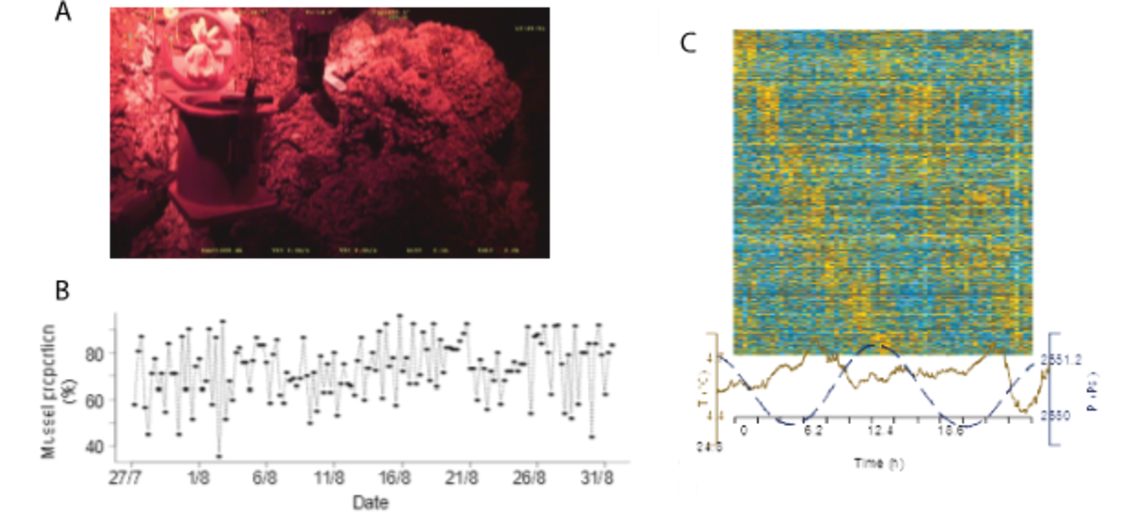Mussels have rhythm in the shells
It has long been thought that deep-sea environments, where light is absent below 1000 m, were "arrhythmic". While circadian rhythms, linked to day/night alternation, occur within all terrestrial living groups and that coastal marine organisms exhibit tidal rhythms, we did not know whether time could influence the physiology of deep-sea animals. The presence of tidal signal at hydrothermal vents started to tickle us regarding its potential role on fauna. Thanks to deep-sea observatories, located on the Mid-Atlantic (EMSO Azores) and Juan de Fuca ridges, we observed that certain organisms were adjusting their behavior to tides (Cuvelier et al., 2014; Lelièvre et al., 2017). Other studies have shown that growth increments related to tides were present on mussel shells (Nedoncelle et al., 2015; Schöne & Giere, 2005). So many clues that let us suspect that tides could play a determining role in the functioning of hydrothermal communities, which we sought to demonstrate in our study.
After confirming the presence of a tidal-related behaviour in the mussel Bathymodiolus azoricus, the star of the Lucky Strike vent field, we designed an original sampling strategy to determine if gene expression also aligned with the tidal cycle. For this, samples were collected over a very specific time window equivalent to 24 hours 48 minutes, at the rate of one sample every 2 hours 4 minutes, corresponding to the tides, quite challenging with a submersible! We also worked under red light since we didn't know if these animals could perceive light. Another novelty of this study: the mussels were "fixed" immediately on the bottom in a hypersaline solution in order to prevent the modification of gene expression during the ascent. Our results show that, at the molecular level and a depth of 1700 m, the temporal transcriptome (i.e. all the expressed genes which provide a snapshot of the physiological state of an organism at an instant "t") exhibits oscillations which period corresponds to tides. This study was the first to reveal, in situ, the presence of biological rhythms on a deep-sea species, both in terms of behavior and molecular sequencing (Mat et al. 2020). Go check the story behind the paper: https://go.nature.com/3m0LwPH.
← Read the 10 success stories published to celebrate 10 years of monitoring on EMSO-Azores → |
References
Cuvelier, D., Legendre, P., Laes, A., Sarradin, P.-M., & Sarrazin, J. (2014). Rhythms and Community Dynamics of a Hydrothermal Tubeworm Assemblage at Main Endeavour Field–A Multidisciplinary Deep-Sea Observatory Approach. PloS One, 9(5), e96924.
Lelièvre, Y., Legendre, P., Matabos, M., Mihaly, S., Lee, R. W., Sarradin, P.-M., Arango, C. P., & Sarrazin, J. (2017). Astronomical and atmospheric impacts on deep-sea hydrothermal vent invertebrates. Proceedings of the Royal Society B: Biological Sciences, 284(1852). https://doi.org/10.1098/rspb.2016.2123
Mat, A. M., Sarrazin, J., Markov, G. V., Apremont, V., Dubreuil, C., Eché, C., Fabioux, C., Klopp, C., Sarradin, P. M., Tanguy, A., Huvet, A., & Matabos, M. (2020). Biological rhythms in the deep-sea hydrothermal mussel Bathymodiolus azoricus. Nature Communications, 11(1), 1–12. https://doi.org/10.1038/s41467-020-17284-4
Nedoncelle, K., Lartaud, F., Contreira Pereira, L., Yücel, M., Thurnherr, A. M., Mullineaux, L. S., & le Bris, N. (2015). Bathymodiolus growth dynamics in relation to environmental fluctuations in vent habitats. Deep-Sea Research Part I: Oceanographic Research Papers, 106, 183–193. https://doi.org/10.1016/j.dsr.2015.10.003
Schöne, B. R., & Giere, O. (2005). Growth increments and stable isotope variation in shells of the deep-sea hydrothermal vent bivalve mollusk Bathymodiolus brevior from the North Fiji Basin, Pacific Ocean. Deep Sea Research Part I: Oceanographic Research Papers, 52(10), 1896–1910. https://doi.org/10.1016/j.dsr.2005.06.003


